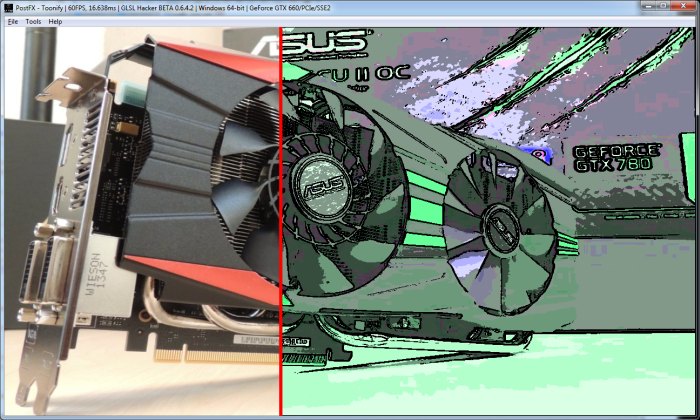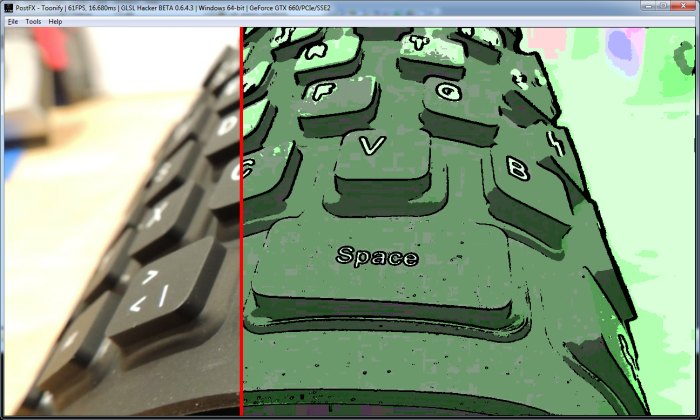
|
|
Here is a new entry in the GLSL Shader Library: a toonify post processing filter. This filter creates a cartoon version of an image. You can use the mouse (the vertical red line) to see the difference between the original and toonified versions of the image.
It would be interesting to update this shader with another edge detector. I’ll do it later. A demo for GLSL Hacker is available in the host_api/PostFX/Toon/ folder of the code sample pack. The latest GLSL Hacker can be downloaded from this page. As usual, this shader can be used in any OpenGL-based app with extremely minor changes only. |
Here is the GLSL fragment shader (for OpenGL 3.2+):
#version 150
uniform sampler2D tex0;
uniform float mouse_x_offset; // 0.5
in vec4 Vertex_UV;
out vec4 FragColor;
uniform float edge_thres; // 0.2;
uniform float edge_thres2; // 5.0;
#define HueLevCount 6
#define SatLevCount 7
#define ValLevCount 4
float[HueLevCount] HueLevels = float[] (0.0,140.0,160.0,240.0,240.0,360.0);
float[SatLevCount] SatLevels = float[] (0.0,0.15,0.3,0.45,0.6,0.8,1.0);
float[ValLevCount] ValLevels = float[] (0.0,0.3,0.6,1.0);
vec3 RGBtoHSV( float r, float g, float b)
{
float minv, maxv, delta;
vec3 res;
minv = min(min(r, g), b);
maxv = max(max(r, g), b);
res.z = maxv; // v
delta = maxv - minv;
if( maxv != 0.0 )
res.y = delta / maxv; // s
else {
// r = g = b = 0 // s = 0, v is undefined
res.y = 0.0;
res.x = -1.0;
return res;
}
if( r == maxv )
res.x = ( g - b ) / delta; // between yellow & magenta
else if( g == maxv )
res.x = 2.0 + ( b - r ) / delta; // between cyan & yellow
else
res.x = 4.0 + ( r - g ) / delta; // between magenta & cyan
res.x = res.x * 60.0; // degrees
if( res.x < 0.0 )
res.x = res.x + 360.0;
return res;
}
vec3 HSVtoRGB(float h, float s, float v )
{
int i;
float f, p, q, t;
vec3 res;
if( s == 0.0 )
{
// achromatic (grey)
res.x = v;
res.y = v;
res.z = v;
return res;
}
h /= 60.0; // sector 0 to 5
i = int(floor( h ));
f = h - float(i); // factorial part of h
p = v * ( 1.0 - s );
q = v * ( 1.0 - s * f );
t = v * ( 1.0 - s * ( 1.0 - f ) );
switch(i)
{
case 0:
res.x = v;
res.y = t;
res.z = p;
break;
case 1:
res.x = q;
res.y = v;
res.z = p;
break;
case 2:
res.x = p;
res.y = v;
res.z = t;
break;
case 3:
res.x = p;
res.y = q;
res.z = v;
break;
case 4:
res.x = t;
res.y = p;
res.z = v;
break;
default: // case 5:
res.x = v;
res.y = p;
res.z = q;
break;
}
return res;
}
float nearestLevel(float col, int mode)
{
int levCount;
if (mode==0) levCount = HueLevCount;
if (mode==1) levCount = SatLevCount;
if (mode==2) levCount = ValLevCount;
for (int i =0; i<levCount-1; i++ ) {
if (mode==0) {
if (col >= HueLevels[i] && col <= HueLevels[i+1]) {
return HueLevels[i+1];
}
}
if (mode==1) {
if (col >= SatLevels[i] && col <= SatLevels[i+1]) {
return SatLevels[i+1];
}
}
if (mode==2) {
if (col >= ValLevels[i] && col <= ValLevels[i+1]) {
return ValLevels[i+1];
}
}
}
}
// averaged pixel intensity from 3 color channels
float avg_intensity(vec4 pix)
{
return (pix.r + pix.g + pix.b)/3.;
}
vec4 get_pixel(vec2 coords, float dx, float dy)
{
return texture(tex0,coords + vec2(dx, dy));
}
// returns pixel color
float IsEdge(in vec2 coords)
{
float dxtex = 1.0 /float(textureSize(tex0,0)) ;
float dytex = 1.0 /float(textureSize(tex0,0));
float pix[9];
int k = -1;
float delta;
// read neighboring pixel intensities
for (int i=-1; i<2; i++) {
for(int j=-1; j<2; j++) {
k++;
pix[k] = avg_intensity(get_pixel(coords,float(i)*dxtex,
float(j)*dytex));
}
}
// average color differences around neighboring pixels
delta = (abs(pix[1]-pix[7])+
abs(pix[5]-pix[3]) +
abs(pix[0]-pix[8])+
abs(pix[2]-pix[6])
)/4.;
//return clamp(5.5*delta,0.0,1.0);
return clamp(edge_thres2*delta,0.0,1.0);
}
void main()
{
vec2 uv = Vertex_UV.xy;
vec4 tc = vec4(1.0, 0.0, 0.0, 1.0);
if (uv.x > (mouse_x_offset+0.002))
{
vec3 colorOrg = texture(tex0, uv).rgb;
vec3 vHSV = RGBtoHSV(colorOrg.r,colorOrg.g,colorOrg.b);
vHSV.x = nearestLevel(vHSV.x, 0);
vHSV.y = nearestLevel(vHSV.y, 1);
vHSV.z = nearestLevel(vHSV.z, 2);
float edg = IsEdge(uv);
vec3 vRGB = (edg >= edge_thres)? vec3(0.0,0.0,0.0):HSVtoRGB(vHSV.x,vHSV.y,vHSV.z);
tc = vec4(vRGB.x,vRGB.y,vRGB.z, 1);
}
else if (uv.x < (mouse_x_offset-0.002))
{
tc = texture(tex0, uv);
}
FragColor = tc;
}
Credits: this shader is based on this coding experiment.
